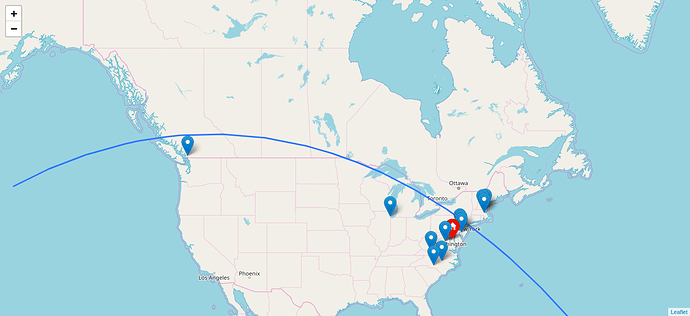New English School, Jabriya, Kuwait, telebridge via K6DUE
The ISS callsign is presently scheduled to be NA1SS
The scheduled astronaut is Serena Aunon-Chancellor KG5TMT
Contact is a go for: Tue 2018-11-13 10:08:08 UTC 50 deg
Several stations were able to receive parts of the contact:
- SatNOGS Network - Observation 322091 - Station: 54 - IntimelyEights-vhf
- SatNOGS Network - Observation 322089 - Station: 246 - SATCOM North Shore
- SatNOGS Network - Observation 322085 - Station: 308 - W4CX
- SatNOGS Network - Observation 322082 - Station: 12 - W2BFJ
- SatNOGS Network - Observation 322084 - Station: 296 - bob
- SatNOGS Network - Observation 322088 - Station: 223 - W2MMD GCARC Clubhouse
- SatNOGS Network - Observation 322086 - Station: 105 - KU2Y
- SatNOGS Network - Observation 320722 - Station: 272 - K3RLD VHF QFH
- SatNOGS Network - Observation 322087 - Station: 177 - KO2F-VHF-1
- SatNOGS Network - Observation 322090 - Station: 256 - KO2F-Test-1
- SatNOGS Network - Observation 322083 - Station: 27 - NB3T - VHF
- SatNOGS Network - Observation 322093 - Station: 336 - Chicago2
- SatNOGS Network - Observation 322092 - Station: 59 - Aardvark Station #1
Map of the ground track, the above mentioned SatNOGS ground stations and the contact site:
Congratulations and 73 to all!
More details about the contact from AMSAT-BB:
Click here for the details
An International Space Station school contact has been planned with participants at New English School, Jabriya, Kuwait on 13 Nov. The event is scheduled to begin at approximately 10:08 UTC. It is recommended that you start listening approximately 10 minutes before this time.The duration of the contact is approximately 9 minutes and 30 seconds. The contact will be a telebridge between NA1SS and K6DUE. The contact should be audible over the east coast of the U.S. and adjacent areas. Interested parties are invited to listen in on the 145.80 MHz downlink. The contact is expected to be conducted in English.
Founded in 1969 (celebrating its 50th year) by Mr. Tareq S. Rajab, New English School (NES) in Jabriya, Kuwait, is a co-educational, English medium private school and has approximately 2300 pupils throughout both the Primary and Secondary sections. NES caters for students aged 4 - 18 years and follows the England/Wales curriculum as part of its educational structure. Students achieve IGCSEs and Advanced Levels in a wide variety of subjects prior to leaving the school and those who successfully graduate from NES often proceed to Higher Education at Universities around the Middle East, in Canada, USA, UK as well as other parts of the globe. STEM topics are very popular at the school and NES places a strong and suitable emphasis on achievement in these key areas.
Participants will ask as many of the following questions as time allows:
-
What inspired you to become an NASA astronaut?
-
What is the most exciting part of being an astronaut?
-
What personal items have you taken with you to the space station?
-
What type of research are you doing on the space station?
-
What happens when you sneeze on the space station?
-
How do you deal with an individual with an emergency medical condition on the space station?
-
How do you cope with living with the same people in a confined space on the space station?
-
Does an astronaut’s immune system change in space?
-
What happens to the blood when your nose bleeds in space?
-
How does being in space affect your sense of taste, smell and touch?
-
What dangers do you face while on the space station?
-
What are your three favourite things about being in space?
-
What has been the scariest experience of your mission so far?
-
What was the first thing that came to mind when you saw Earth for the first time from space?
-
If Sally Ride or Valentina Tereshkova turned up today, what would you like to ask or say to them?
-
What will you do after your mission has ended?
-
Does acid build up inside your stomach or esophagus?
-
How does it feel when you are in zero gravity?
-
How did you feel when you woke up for the first time on the space station?
-
How do you entertain yourself while on the space station?
-
How did your family react when they found out that you were going into space?
-
What do you miss most about Earth when you’re in space?
[…]
About ARISS:
Amateur Radio on the International Space Station (ARISS) is a cooperative venture of international amateur radio societies and the space agencies that support the International Space Station (ISS). In the United States, sponsors are the Radio Amateur Satellite Corporation (AMSAT), the American Radio Relay League (ARRL), the Center for the Advancement of Science in Space (CASIS) and National Aeronautics and Space Administration (NASA). The primary goal of ARISS is to promote exploration of science, technology, engineering, and mathematics (STEM) topics by organizing scheduled contacts via amateur radio between crew members aboard the ISS and students in classrooms or informal education venues. With the help of experienced amateur radio volunteers, ISS crews speak directly with large audiences in a variety of public forums. Before and during these radio contacts, students, teachers, parents, and communities learn about space, space technologies, and amateur radio. For more information, see www.ariss.org, www.amsat.org, and www.arrl.org.
Thank you & 73,
David - AA4KN
